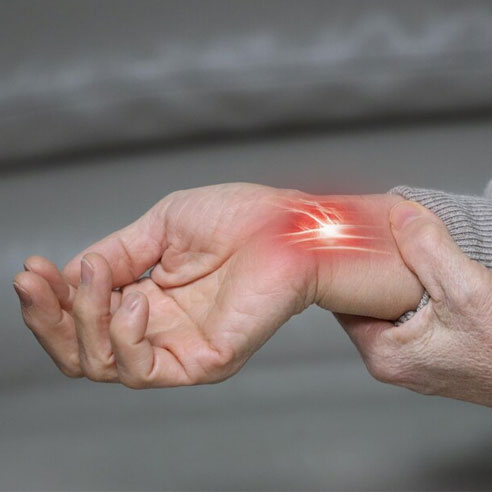Tingling and Numbness
Tingling and numbness primarily affect the thumb, index, and middle fingers, disrupting sensation and causing discomfort frequently.
Carpal Tunnel Syndrome (CTS) is a condition caused by compression of the median nerve in the wrist. This nerve controls movement and sensation in the hand, and when compressed, it leads to pain, tingling, numbness, and weakness, especially in the thumb and fingers. Common causes include repetitive hand movements, poor posture, and certain health conditions like diabetes or arthritis. Osteopathy addresses the underlying factors contributing to CTS, such as tension in the neck, shoulder, and wrist muscles, improving circulation, mobility, and overall function. With the right treatment, CTS symptoms can be managed, providing lasting relief and restoring hand function.

Inherited traits may contribute to a higher likelihood of developing carpal tunnel syndrome symptoms over time.
Frequent hand activities like typing or knitting can strain wrist nerves, increasing compression risk significantly.
Underlying issues like diabetes or arthritis may eventually lead to nerve inflammation and pressure development.
Injuries from falls or repetitive impacts can cause swelling, compromising the median nerve's function.

Tingling and numbness primarily affect the thumb, index, and middle fingers, disrupting sensation and causing discomfort frequently.
Reduced grip strength makes it difficult to handle objects effectively, leading to increased frustration and everyday limitations easily.
Persistent wrist or hand pain intensifies during repetitive activities or rest periods, significantly affecting daily tasks commonly.
Clinical tests, nerve conduction studies, and physical examinations identify nerve compression and clarify specific condition.
Carpal Tunnel Syndrome (CTS) develops when the median nerve, passing through the carpal tunnel in the wrist, experiences compression or irritation. This condition can arise from repetitive hand movements, wrist trauma, or systemic conditions like diabetes and arthritis that increase swelling or nerve inflammation. Poor wrist posture, prolonged typing, or frequent use of vibrating tools may also contribute to nerve pressure. The condition typically progresses over time, starting with mild symptoms such as tingling or numbness, eventually leading to pain, weakness, and limited hand functionality. Understanding the root causes is crucial for timely diagnosis and effective treatment to restore mobility and reduce discomfort.

Frequent repetitive movements strain wrist structures, contributing to nerve compression and reduced functionality over time.
Improper wrist alignment significantly impacts nerve pathways, increasing the risk of chronic irritation and long-term complications.
Underlying conditions like arthritis or diabetes disrupt circulation, leading to swelling and nerve inflammation development.
Tight muscles and restricted joints hinder efficient nerve function, potentially aggravating existing compression-related issues.
Find effective relief with tailored osteopathic treatments, reducing discomfort, enhancing function, and restoring hand mobility naturally.
Osteopathy offers a holistic approach to treating Carpal Tunnel Syndrome (CTS) by addressing the root causes. Rather than focusing solely on the wrist, osteopathic treatment considers the entire upper body, including the neck, shoulders, and forearms. Osteopaths assess posture, muscular tension, joint mobility, and nerve function to identify areas of restriction that could be contributing to nerve compression. Treatment may include gentle manipulations, stretching, and techniques aimed at improving circulation and relieving muscle tension. This comprehensive approach not only reduces symptoms but also promotes long-term healing by improving overall function and reducing the risk of recurrence.

Carpal Tunnel Syndrome is caused by pressure on the median nerve, often due to repetitive hand movements, poor posture.
Yes, physiotherapy addresses the root causes of CTS by improving posture, joint mobility, and muscle tension to reduce nerve compression.
Treatment duration varies based on the severity of symptoms, but many patients experience relief after a few sessions.
Without proper treatment, CTS can lead to long-term nerve damage, but osteopathy can help manage and alleviate symptoms effectively.
© All Rights Reserved by Kriston Healthcare